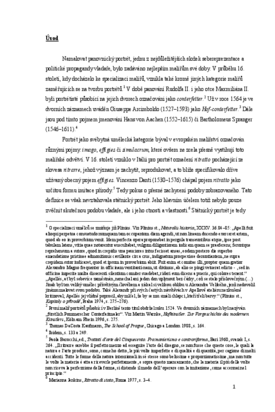Ikonografie Rudolfa II.
Iconography of Rudolf II.
dissertation thesis (DEFENDED)

View/
Permanent link
http://hdl.handle.net/20.500.11956/72890Identifiers
Study Information System: 103737
CU Caralogue: 990017840650106986
Collections
- Kvalifikační práce [24984]
Author
Advisor
Referee
Fučíková, Eliška
Seifertová, Hana
Faculty / Institute
Faculty of Arts
Discipline
History and Visual Arts
Department
Institute of Art History
Date of defense
17. 6. 2014
Publisher
Univerzita Karlova, Filozofická fakultaLanguage
Czech
Grade
Pass
Keywords (Czech)
Rudolf II, ikonografie, portréty, alegorie, malířství, sochařstvíKeywords (English)
Rudolf II, iconography, portraits, allegories, painting, sculptureBěhem Rudolfova života bylo vytvořeno mnoho jeho podobizen, které tvoří významnou součást rudolfínského umění. Doposud jim byla věnována pozornost pouze okrajově. Dokumentují především proměnu Rudolfova vzhledu, ale i jeho stylizaci do fiktivních rolí. Hlavním úkolem portrétů bylo představit Rudolfovu podobu a zdůraznit význam jeho osobnosti. Velká část podobizen ukazuje Rudolfa jako dobrého císaře a skvělého bojovníka, ačkoliv tato znázornění zcela neodpovídají realitě. Zvláštní kapitolou jsou složité alegorie oslavující Rudolfovu vládu pomocí mytologických postav, personifikací a symbolů vyskytujících se na jeho osobních impresách. Většina jeho podobizen vychází z portrétních schemat typických pro 16. století - busty, celofigurové portréty, nebo jezdecké portréty. Výjimečným dílem je však obraz Rudolf jako Vertumnus od Giuseppe Arcimbolda, který v sobě zahrnuje klasický portrétní typ s alegorickými prvky.
Many portraits of Rudolf II were painted and created during his lifetime, forming a significant component of Rudolfine art, however, they have not received a sufficient art historical attention. They document, at times at stylyzed manner, the transformation of Rudolf's appearance. However, their most important task was to demonstrate and make tangeable Rudolf's authentic appearance to the world and to celebrate his magnanimity and personality. Thus, there are many portraits that represent Rudolf as a good emperor or a brilliant commander, although, as we know, they did not correspond to reality. A special chapter of the portrait iconography also create complicated allegories about Rudolf's reign relying on representations of personifications, mythological and animal symbols using Rudolf's personal impresa. Most of the portraits follow former portrait types typical for the 16th century, as bust, standing figure or equestrian monument. However, the peculiarity for Rudolfine portraiture is the allegorical portrait Rudolf as Vertumnus painted by Giuseppe Arcimboldo that combines classical portrait with allegory.
